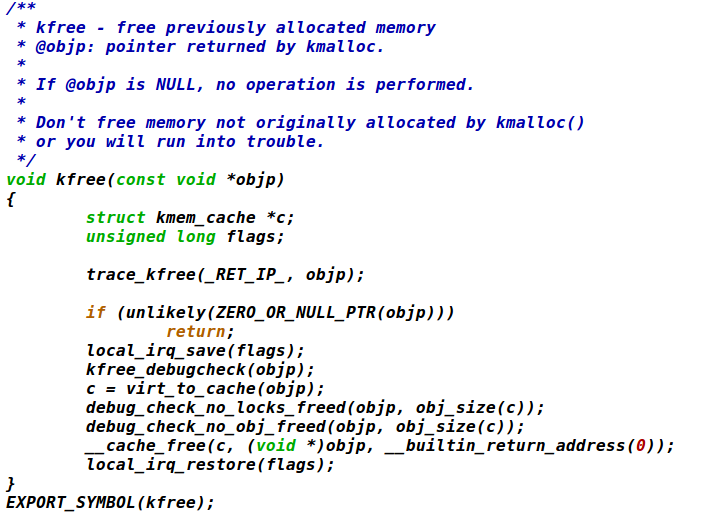Linux字符设备学习,总结
注册字符驱动的一种老方法:
注册一个字符设备的经典方法是使用:
int register_chrdev(unsigned int major, const char *name, structfile_operations *fops);
这里, major 的主编号, name 是驱动的名子(出现在 /proc/devices),
fops file_operations 结构. 一个对 register_chrdev 的调用为给定的主编号注册 0 - 255 的次编号, 并且为每一个建立一个缺省的 cdev 结构。使用这个接口的驱动必须准备好处理对所有 256 个次编号的 open 调用( 不管它们是否对应真实设备 ), 它们不能使用大于 255 的主或次编号。
如果你使用 register_chrdev, 从系统中去除你的设备的正确的函数是:
int unregister_chrdev(unsigned int major, const char *name);
major 和 name 必须和传递给 register_chrdev 的相同, 否则调用会失败.

现在常用的方法,cdev
包含 <linux/cdev.h>, 这个结构和它的关联帮助函数定义在这里.

/** * cdev_init() - initialize a cdev structure * @cdev: the structure to initialize * @fops: the file_operations for this device * * Initializes @cdev, remembering @fops, making it ready to add to the * system with cdev_add(). */ void cdev_init(struct cdev *cdev, const struct file_operations *fops) { memset(cdev, 0, sizeof *cdev); INIT_LIST_HEAD(&cdev->list); kobject_init(&cdev->kobj, &ktype_cdev_default); cdev->ops = fops; }
struct cdev 有一个拥有者成员, 应当设置为THIS_MODULE.
一旦 cdev 结构建立, 最后的步骤是把它告诉内核, 调用:
int cdev_add(struct cdev *dev, dev_t num, unsigned int count);
/** * cdev_add() - add a char device to the system * @p: the cdev structure for the device * @dev: the first device number for which this device is responsible * @count: the number of consecutive minor numbers corresponding to this * device * * cdev_add() adds the device represented by @p to the system, making it * live immediately. A negative error code is returned on failure. */ int cdev_add(struct cdev *p, dev_t dev, unsigned count) { p->dev = dev; p->count = count; return kobj_map(cdev_map, dev, count, NULL, exact_match, exact_lock, p); }
这里, dev 是 cdev 结构, dev 是这个设备响应的第一个设备号, count 是应当关联到设备的设备号的数目. 常常 count 是 1
在使用 cdev_add 是有几个重要事情要记住. 除非你的驱动完全准备好处理设备上的操作, 否则你不应当调用 cdev_add。
第一个是这个调用可能失败. 如果它返回一个负的错误码, 你的设备没有增加到系统中.
它几乎会一直成功,但是, 并且带起了其他的点: cdev_add 返回, 你的设备就是"活的",并且内核可以调用它的操作.
从系统去除一个字符设备, 调用:
void cdev_del(struct cdev *dev);
/** * cdev_del() - remove a cdev from the system * @p: the cdev structure to be removed * * cdev_del() removes @p from the system, possibly freeing the structure * itself. */ void cdev_del(struct cdev *p) { cdev_unmap(p->dev, p->count); kobject_put(&p->kobj); }
显然, 你不应当在传递给 cdev_del 后存取 cdev 结构。
引入 2 个核心函数来管理 Linux 内核中的内存. 这些函数, 定义
在 <linux/slab.h>, 是:
void *kmalloc(size_t size, int flags);

void kfree(void *ptr);

1 #define offsetof(TYPE, MEMBER) ((size_t) &((TYPE *)0)->MEMBER) 2 3 /** 4 * container_of - cast a member of a structure out to the containing structure 5 * @ptr: the pointer to the member. 6 * @type: the type of the container struct this is embedded in. 7 * @member: the name of the member within the struct. 8 * 9 */ 10 #define container_of(ptr, type, member) ({ \ 11 const typeof( ((type *)0)->member ) *__mptr = (ptr); \ 12 (type *)( (char *)__mptr - offsetof(type,member) );})
container_of的功能,通过结构体成员的地址,获得结构体的首地址。
以下是简单用法:


